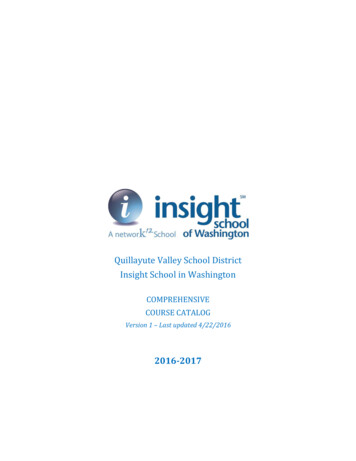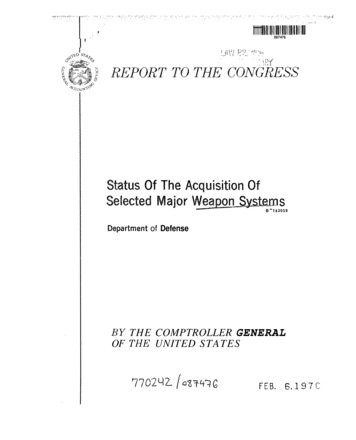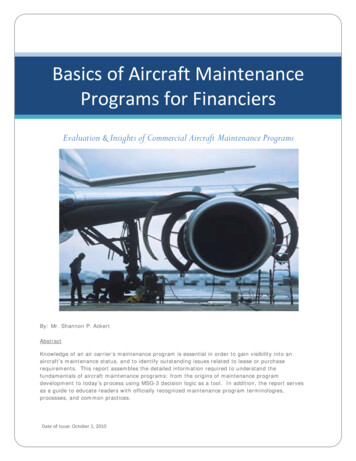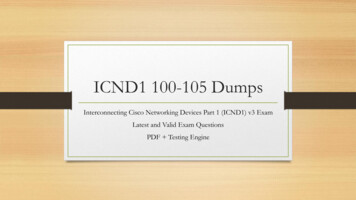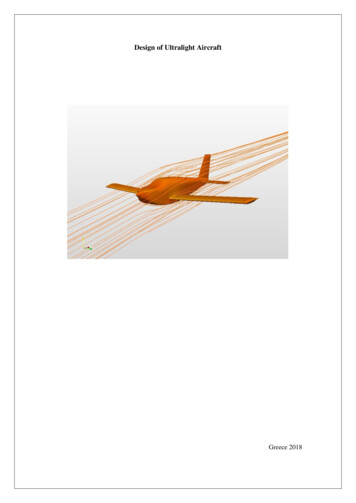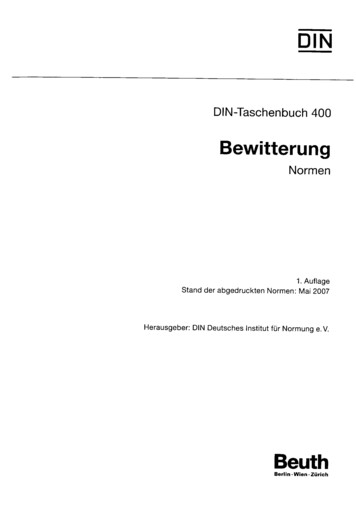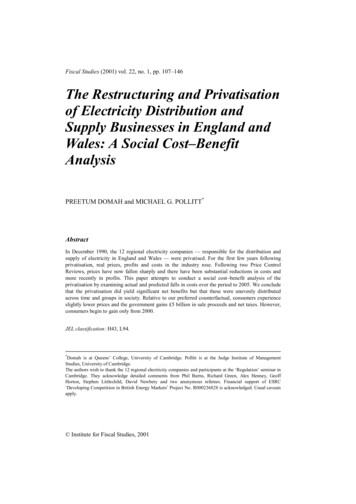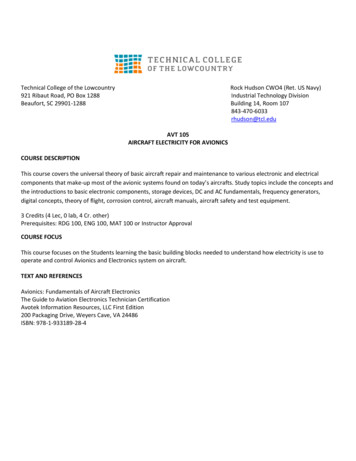
Transcription
Technical College of the Lowcountry921 Ribaut Road, PO Box 1288Beaufort, SC 29901-1288Rock Hudson CWO4 (Ret. US Navy)Industrial Technology DivisionBuilding 14, Room 107843-470-6033rhudson@tcl.eduAVT 105AIRCRAFT ELECTRICITY FOR AVIONICSCOURSE DESCRIPTIONThis course covers the universal theory of basic aircraft repair and maintenance to various electronic and electricalcomponents that make-up most of the avionic systems found on today’s aircrafts. Study topics include the concepts andthe introductions to basic electronic components, storage devices, DC and AC fundamentals, frequency generators,digital concepts, theory of flight, corrosion control, aircraft manuals, aircraft safety and test equipment.3 Credits (4 Lec, 0 lab, 4 Cr. other)Prerequisites: RDG 100, ENG 100, MAT 100 or Instructor ApprovalCOURSE FOCUSThis course focuses on the Students learning the basic building blocks needed to understand how electricity is use tooperate and control Avionics and Electronics system on aircraft.TEXT AND REFERENCESAvionics: Fundamentals of Aircraft ElectronicsThe Guide to Aviation Electronics Technician CertificationAvotek Information Resources, LLC First Edition200 Packaging Drive, Weyers Cave, VA 24486ISBN: 978-1-933189-28-4
COURSE GOALSThe following list of course goals are address in the course. These goals related directly to the performance objectives(Addendum A). (*designates a CRUCIAL goal).*1. Understanding Fundamentals of Direct Current2. Recognizing the Basic Components used in Avionics*3. Comprehending the Concepts of Alternating Current4. Identify how Electricity is Generated and Stored*5. Describe to uses of various Solid–State Components*6. Describe to uses of various Advanced Solid–State Components7. Define the different classifications of Alternators and Generators*8. Grasp the basics understanding of Digital Theory9. Comprehend the Fundamentals of Aircraft Flight*10. Define how the different types of Corrosion that impact Avionics and Electronics on Aircrafts*11. Clarify and explain the critical use of Aircraft Manuals and Schematics to Troubleshoot and Repair Aircraft.*12. Learn the important of Aircraft Safety around the Aircraft and the Workplace*13. Explain Tool Usage and Tool ControlSTUDENT CONTRIBUTIONEach student need to spend at least 6 hours per week preparing and completing their classwork or on-line assignmentsto turn in weekly. Attendance is critical in this class.Student Attendance Policy: See student handbook within course catalog.COURSE EVALUATIONEach week's assignments are worth 100 points and averaged over the semester. Chapter tests are also worth 100 pointsand averaged at the end of the semester. The final will be 100 points.Tests: 50% Assignments: 45%Timeliness/Attendance/Participation: 5%COURSE SCHEDULEThe schedule for this course is provided in Blackboard on the Assignments page. It is important that all instructions inBlackboard be followed carefully as some assignments are completed and turn-in to the instructor and some areuploaded in Blackboard for gradingApproved by: Kelli Boniecki Developed/Revised: July 7, 2019Division Dean for Business & Industrial Divisions
ADA STATEMENTThe Technical College of the Lowcountry provides access, equal opportunity and reasonable accommodation in itsservices, programs, activities, education and employment for individuals with disabilities. To request disabilityaccommodation, contact the counselor for students with disabilities at (843) 525-8228 during the first ten business daysof the academic term.ACADEMIC MISCONDUCTThere is no tolerance at TCL for academic dishonesty and misconduct. The College expects all students to conductthemselves with dignity and to maintain high standards of responsible citizenship.It is the student’s responsibility to address any questions regarding what might constitute academic misconduct to thecourse instructor for further clarification.The College adheres to the Student Code for the South Carolina Technical College System. Copies of the Student Codeand Grievance Procedure are provided in the TCL Student Handbook, the Division Office, and the Learning ResourcesCenter.ATTENDANCE The College’s statement of policy indicates that students must attend ninety percent of total class hours or they willbe in violation of the attendance policy. Students not physically attending class during the first ten calendar days from the start of the semester must bedropped from the class for NOT ATTENDING. Students taking an online/internet class must sign in and communicate with the instructor within the first tencalendar days from the start of the semester to indicate attendance in the class. Students not attending classduring the first ten calendar days from the start of the semester must be dropped from the class for NOTATTENDING. Reinstatement requires the signature of the division dean. In the event it becomes necessary for a student to withdraw from the course OR if a student stops attending class, itis the student’s responsibility to initiate and complete the necessary paperwork. Withdrawing from class may haveconsequences associated with financial aid and time to completion. When a student exceeds the allowed absences, the student is in violation of the attendance policy. The instructorMUST withdrawal the student with a grade of “W”, “WP”, or “WF” depending on the date the student exceeded theallowed absences and the student’s progress up to the last date of attendanceOR Under extenuating circumstances and at the discretion of the faculty member teaching the class, allow the studentto continue in the class and make-up the work. This exception must be documented at the time the allowedabsences are exceeded. Absences are counted from the first day of class. There are no "excused" absences. All absences are counted,regardless of the reason for the absence. A student must take the final exam or be excused from the final exam in order to earn a non-withdrawal grade. A copy of TCL’s STATEMENT OF POLICY NUMBER: 3-1-307 CLASS ATTENDANCE (WITHDRAWAL) is on file in theDivision Office and in the Learning Resources Center.
ONLINE ATTENDANCE PROCEDUREFor all online courses, students must complete an assignment designated by the instructor during the first week ofclasses. The instructor will drop the student from the course if the initial assignment is not completed.Instructors will withdraw students from the class when 90% attendance is not maintained. Attendance in an onlinecourse is defined by regular course access and by timely completion of assignments as required by the instructor. Eachstudent will be expected to access the web class at least once a week and complete 90% of assignments on time.Additional access is encouraged and may be necessary for successful completion of classes.Failure to log in and complete assignments will result in the student being withdrawn from the course. The instructorwill assign a grade of “W,” “WP,” or “WF” based upon the student’s academic standing as of the last date of attendance,which is the last login. Students are responsible for any financial matters associated with an administrative withdrawal. Ifa student fails to email the instructor (using the my.tcl.edu email account) requesting to be dropped from the course andhas not submitted the initial assignment required during the first week of class, the instructor will assign a “NeverAttended” code in the student information system (Self-Service) no later than ten calendar days after the first day of theclass. Students who are dropped as a result of never attending the course are still responsible for all fees associated withthe course.HAZARDOUS WEATHERIn case weather conditions are so severe that operation of the College may clearly pose a hardship on students and stafftraveling to the College, notification of closing will be made through the following radio and television stations: WYKZ98.7, WGCO 98.3, WGZO 103.1, WFXH 106.1, WWVV 106.9, WLOW 107.9, WGZR 104.9, WFXH 1130 AM, WLVH 101.1,WSOK 1230 AM, WAEV 97.3, WTOC TV, WTGS TV, WJWJ TV, and WSAV TV. Students, faculty and staff are highlyencouraged to opt in to the Emergency Text Message Alert System. www.tcl.edu/textalert.asp.EMERGENCY TEXT ALERTStudents, faculty and staff are highly encouraged to opt in to the Emergency Text Message Alert System. Participantsreceive immediate notification of emergency events and weather cancelations via text messaging on their cell phones.Participants can also opt in to receive non-emergency news and announcements. Go to www.tcl.edu. On thehomepage, click on “emergency Text Alert at TCL” and fill out the form or go to www.tcl.edu/textalert.aspSyllabus Safety AddendumPurposeThe purpose of this safety addendum is to provide each student with safety guidelines during an incident, emergency, ordisaster at TCL. In addition, it provides students guidelines for lockdown procedures, evacuation procedures, and activeshooter.
DefinitionAn incident is any event, potential or actual, that may impact normal operations but has no immediate health or lifethreatening consideration or serious effect on the overall functional capacity of the College. An event of this natureshould be reported to the Office of the Vice President for Administrative Services. Also, notify the off-site campusadministrator if applicable.An emergency is any incident, potential or actual, which may endanger life or health or which affects an entire buildingor buildings, and will disrupt the overall operations of the College. Outside emergency services will probably be required,as well as major efforts from campus support services. Major policy considerations and decisions will usually be requiredfrom the college administration during times of crises. An emergency should be reported immediately by directly using911 if life or health/injury considerations exist and then to the Office of the President or Vice President forAdministrative Services as quickly as possible. Also, notify the off-site campus administrator if applicable.A disaster is any event or occurrence that has taken place and has seriously impaired or halted the operations of theCollege. In some cases, mass personnel casualties and severe property damage may be sustained. A coordinated effortof all campus-wide resources is required to effectively control the situation. Outside emergency services will beessential. In all cases of disaster, an Emergency Control Center will be activated, and the appropriate support andoperational plans will be executed. The disaster should be immediately reported, first by calling 911 and then to theOffice of the President or Vice President for Administrative Services. Also, notify the off-site campus administrator ifapplicable. Types of EmergenciesHurricaneTornadoFireBiochemical or Radiation SpillExplosion/BombDowned Aircraft (crash which directly impacts campus operations)Utility FailuresViolent or criminal behaviorPsychological Crisis
ProceduresActive Shooter Run/hide/fight video at nd-mass-casualtyincidents/run-hide-fight-video )Building Evacuation1. Building evacuations occur when an alarm sounds and/or upon notification by Security or the Emergency Director.2. When the building evacuation alarm is activated during an emergency, individuals should exit according to thebuilding evacuation plan and alert others to do the same.3. Once outside, individuals should proceed to a clear area that is at least 500 feet away from the affected building.Streets, fire lanes, hydrant areas and walkways should be kept clear for emergency vehicles and personnel.4. Individuals should not return to an evacuated building unless told to do so by Security or the Emergency Director.5. Individuals should assist persons with disabilities in exiting the building. Elevators are reserved for disabled personsCampus Evacuation1. A uniformed Security Guard, the Emergency Director, or an Emergency Resource Team member will announceevacuation of all or part of the campus grounds.2. All persons (students and staff) are to immediately vacate the campus, or in the case of a partial evacuation relocateto another part of the campus grounds as directed.Lockdown1. Clear the halls2. Report to the nearest classroom/office3. Assist those needing special assistance4. Ensure classroom/office doors are closed and locked5. Turn off lights6. Stay away from doors and windows (out of the line of sight)7. BE QUIET and follow instructor’s directions8. Silence cell phones9. Wait for the “All Clear” before leaving
9. Comprehend the Fundamentals of Aircraft Flight *10. Define how the different types of Corrosion that impact Avionics and Electronics on Aircrafts *11. Clarify and explain the critical use of Aircraft Manuals and Schematics to Troubleshoot and Repair Aircraft. *12. Learn the important of A
